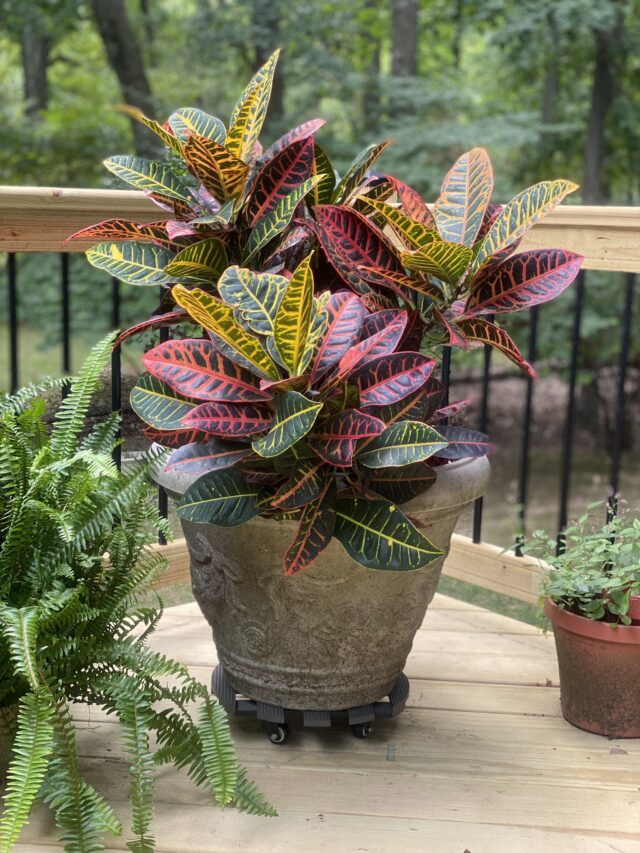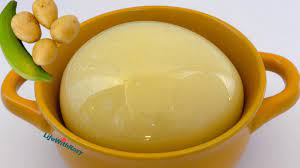Croton plant-can be indoor or outdoor
Croton plants are loved by many for their beautiful and unique foliage, but did you know there are numerous health benefits associated with them as well?
In this article, I herein examine the science behind this plant.
Croton, Science
The Croton plant, scientifically known as Codiaeum variegatum, is a vibrant and colorful tropical shrub belonging to the Euphorbiaceae family.
Other names for the Croton plant include Joseph’s Coat, Garden Croton, and Variegated Laurel. The name “Joseph’s Coat” is a reference to the biblical story of Joseph, who wore a colorful coat, much like the plant’s vibrant foliage.
Originating from Southeast Asia and the western Pacific Islands, the Croton plant has been cultivated and admired for centuries due to its stunning foliage.
It has become increasingly popular in recent years for its various health benefits.
It typically grows up to four meters tall and produces small yellow flowers with bright orange-red fruits. The leaves are leathery, glossy green on top and grayish-white underneath.
In traditional medicine, croton has been used as a purgative to treat constipation and other digestive issues.
In some regions, the leaves and roots were crushed and applied externally to treat skin conditions like rashes, wounds, and insect bites.
The main benefits of using croton plants are related to their antioxidant properties, which can help protect against oxidative stress caused by environmental pollutants like smoke or ozone.
Additionally, extracts from the plant have been found to possess anti-inflammatory properties that can reduce swelling associated with arthritis pain as well as aid in wound healing.
Other potential benefits include promoting blood circulation, stimulating appetite, treating skin conditions such as eczema or psoriasis, and even helping with weight loss.
Due to its eye-catching appearance, the Croton plant is often used for landscaping, horticulture, and as an accent plant in interior design.
With proper care, it can thrive in tropical and subtropical climates or as an indoor plant in regions with colder climates. Its low maintenance requirements and stunning beauty continue to make it a popular choice among plant enthusiasts and horticulturists alike.
Nutritional Content of Croton Plant
The Croton plant is a nutritional powerhouse, packed to the brim with vitamins and minerals that are nothing short of miraculous!
Here’s a table summarizing the nutritional profile of the Croton plant, based on the current data (These values represent the nutritional composition of both the leaf and seed of the Croton plant).
Nutritional Parameters
Leaf (g/100 g)
Seed (g/100 g)
Moisture
7.88
7.94
Ash
9.28
4.15
Crude protein
13.13
9.64
Crude fibre
16.63
15.45
Crude fat
15.42
26.73
Carbohydrate
55.35
67.09
Potassium (g/100 g)
1.682
2.224
Calcium (g/100 g)
3.043
1.999
Titanium (g/100 g)
0.026
0.036
Iron (mg/100 g)
275.030
467.530
Manganese (mg/100 g)
71.210
71.610
Strontium (mg/100 g)
707.800
869.270
Source: Bello et al.(2014) Nutrient Contents and Fatty Acids Profiles of Leaves and Seeds of Croton zambesicus
Croton Plant , Science
One study by Salatino et al.(2007) published in the Journal of the Brazilian Chemical Society, showed that Croton has over 1,300 species in tropical regions, and is being used in Africa, Asia, and South America in traditional healing.
Support Hair Growth
Foodnurish.com report that in Chad, the Basara tribe’s women have maintained their long, healthy hair using chebe powder, an ancient hair-care secret made from natural ingredients like shébéseeds (from the Croton zambesicus plant), mahllaba soubianeseeds, missic stone, cloves, and samour resin.
Chebe is gaining popularity among those with Afro-textured hair, as it is believed to reduce breakage and shedding, promoting hair health and growth.
Natural hair-care brands are now incorporating chebe powder into their formulations to help with length retention.
Although messy and staining, chebe’s potential benefits have sparked interest and curiosity in the West as a miracle growth treatment.
Digestive Health
Webmed.com explained that Croton seeds have been used in managing different digestive issues, such as gallbladder problems, colic, and blocked intestines.
Cardiovascular Health
A study by Asare et al.(2015) explored the effects of Croton membranaceus (CM) on cardiovascular disease (CVD) markers. In experiments with rats and mice, CM extract showed a positive impact on lipid profile, reducing triglycerides, increasing HDL cholesterol, and decreasing LDL cholesterol.
It also exhibited anti-inflammatory effects. Additionally, CM extract and metformin lowered blood glucose levels significantly.
These findings suggest that CM could be a potential natural remedy for managing CVD risk factors like high cholesterol and inflammation.
In another study, Ayza et al.(2019) examined the antioxidant and cardioprotective properties of Croton macrostachyus, a plant used in traditional medicine to manage heart diseases in Ethiopia.
They found that Croton macrostachyus may have cardioprotective benefits.
Finally, research by Afriyie et al.(2013) studied the effects of Croton membranaceus (CM) extract on rats for 90 days.
Different doses of CM extract were given to the rats to examine the impact on diverse health markers. The results showed that CM extract is safe and does not cause harm to the rats.
Furthermore, the researchers found that the extract supports the heart by reducing triglyceride levels and cardiac enzymes, whichmeans it might be useful in preventing heart-related problems.
Generally, the study recommends that CM extract could have positive effects on heart health without causing any toxic side effects.
Respiratory Health
One study by Serra et al.(2019) examined the potential benefits of using Croton zehntneri essential oil (EOCZ) in an ovalbumin-induced asthma model in mice. They found that EOCZ had a positive effect on respiratory mechanics, reducing lung injury caused by asthma.
The essential oil’s antioxidant properties appeared to be the primary mechanism responsible for this improvement. The studyrecommends that EOCZ could be a natural drug for asthma treatment, but further research is needed for confirmation.
A recent study by Lima et al.(2020) examined Croton zehntneriessential oil (EOCz) and its major components, anethole, and estragole, for their antispasmodic effects on tracheal muscle.
In Wistar rats’ tracheal rings, EOCz, anethole, and estragoleeffectively inhibited contractions induced by different stimuli. The compounds appeared to block Voltage-Dependent Calcium Channels (VDCC) as part of their mechanism of action.
Anethole straightly inhibited Ca2+ current through VDCC. These findings mean that EOCz and its constituents possess antispasmodic activity and have potential as therapeutic agents for respiratory conditions.
Studies have also shown that regular consumption of croton oil can help reduce symptoms associated with allergic rhinitis, including runny nose, sneezing, and watery eyes.
Immune System
Rath et al.(2011) in-vitro studies examinedthe antibacterial and antioxidant activities of Croton roxburghii leaves and bark extracts.
The acetone extract exhibited the highest antibacterial activity against human pathogenic bacteria, while the aqueous extract had the least activity.
The extracts showed antioxidant properties with varying levels of activity.
This suggests that Croton roxburghii leaves and bark extracts have potential antibacterial and antioxidant activities.
Skincare
Patents.google.com reports a patent cosmetic composition that contains croton plant lechleri resin extract for skincare. The patent company, a Korean cosmetic claims that a cosmetic composition containing a Croton Lechleri resin extract can improve skin moisturization, elasticity, anti-aging, and skin whitening, and offer antibacterial and anti-inflammatory effects.
The composition contains 0.0001-20 wt% of the Croton Lechleriresin extract, which includes active ingredients like proanthocyanidin and taspine. The extract is prepared by leaching the resin in water or an organic solvent, purifying, and extracting.
The study points to the many types and time points for examining the effects of cosmetic composition on the skin.
Treat Diabetes
A recent study by Espinoza-Hernández et al.(2023) found 17 Croton species that exhibited helpful effects against diabetes, such as lowering blood sugar levels, reducing lipid levels, and having antioxidant and anti-inflammatory properties.
These effects were achieved through mechanisms like inhibiting certain enzymes, increasing insulin secretion, and enhancing glucose uptake. Some species even demonstrated antihyperglycemic properties despite lacking traditional use for diabetes treatment.
They recommend more research on these plants for the possible development of natural drugs for diabetes treatment.
Neurological Diseases
One study by Gupta et al.(2020) explored the effects of an extract from the Croton tiglium plant (CTE) on brain cells involved in inflammation and neurodegeneration.
They found that CTE reduced the harmful inflammation caused by microglia, a type of brain cell while increasing their protective abilities.
CTE also encourages the production of a neurotrophic factor that helps support healthy neurons. Additionally, the culture medium from CTE-treated cells enhanced the survival of neurons, representing a neuroprotective effect.
Although CTE is a poisonous plant, when used in controlled amounts, it showed potential as a therapeutic agent for neurological disorders involving inflammation.
Fighting Cancer
Croton plants have been found to inhibit cancer cell growth. One study by Njoya et al.(2018) examined three Croton plant species to determine their potential health benefits.
They tested different extracts from these plants for antioxidant, anti-inflammatory, and cancer-fighting properties.
They found that the extracts from C. gratissimus were less harmful to healthy cells and more selective against cancer cells, making them promising for cancer treatment.
These extracts also exhibited good antioxidant and anti-inflammatory effects. The study suggests that the active compounds in C. gratissimus could be used as an alternative treatment for cancer and other diseases related to oxidative stress.
However, more research is needed to fully understand their mechanisms and potential as therapeutic agents.
Croton Plant, Spiritual Meaning
Croton plants are believed to have spiritual meaning in various cultures and traditions. In some spiritual practices, croton plants are associated with creativity, passion, and abundance. The energy of croton plants is thought to stimulate the sacral chakra, which is associated with creativity, sexuality, and emotional balance. The bright and colorful foliage of the Croton plant is also believed to represent abundance and prosperity in some spiritual practices.
In Jamaican spirituality, croton plants are believed to have protective properties and are used in various rituals and ceremonies. They are also associated with the goddess Oshun, who is associated with love, fertility, and creativity.
Croton Plant. Warning
Head Swell
In a study in 1840, a case was reported of a young woman who inadvertently applied Croton oil (Oleum Tiglii) to her hair, mistaking it for hair oil due to its small bottle size.
The Croton oil caused significant swelling and puffiness of her head and eyelids, leading to great discomfort.
Although Croton oil is known for its potency as an irritant, this case highlighted the extraordinary and rapid absorbing power of human hair.
With cold applications and purgatives, her symptoms subsided, emphasizing the importance of being cautious with the use of potent substances like Croton oil.
Harm liver and DNA
In a study by Rampa et al.(2022)four croton plant species were tested for their potential anti-inflammatory properties. All species were found to reduce nitric oxide production without causing significant harm to cells.
C. gratissimus had the best results, but it also showed a potential risk for steatosis (fatty liver) and genotoxicity (DNA damage).
In conclusion, the study concluded that though these plants have anti-inflammatory components, their possible harmful effects on the liver and DNA could limit their use in drug development.
The writer is a Professor of Naturopathic Healthcare, a Medical Journalist, an author, and a science writer. E. mail: professor40naturopathy@gmail.com. For more about me,Visit: profnyarkotey.com
References
1. Antonio Salatino; Maria L. Faria Salatino; Giuseppina Negri(2007) Traditional uses, chemistry and pharmacology of Croton species (Euphorbiaceae). Review • J. Braz. Chem. Soc. 18 (1) • 2007 • https://doi.org/10.1590/S0103-50532007000100002.
2. Asare GA, Adjei S, Afriyie D, Appiah-Danquah AB, Asia J, Asiedu B, Santa S, Doku D. Croton membranaceusImproves Some Biomarkers of Card iovascular Disease and Diabetes in Genetic Animal Models. J Clin Diagn Res. 2015 Dec;9(12):OF01-5. doi: 10.7860/JCDR/2015/14844.6899. Epub 2015 Dec 1. PMID: 26816938; PMCID: PMC4717687.
3. Arya et al.(2019) Cardioprotective Effect of Croton macrostachyus Stem Bark Extract and Solvent Fractions on Cyclophosphamide-Induced Cardiotoxicity in Rats. Evidence-Based Complementary and Alternative Medicine. Article ID 8467406 | https://doi.org/10.1155/2020/8467406
4. Afriyie DK, Asare GA, Bugyei K, Asiedu-Gyekye I, GyanBA, Adjei S, Addo P, Sittie A, Nyarko AK. Anti-atherogenic and anti-ischemic potentials of Croton membranaceus observed during sub-chronic toxicity studies. Pharmacognosy Res. 2013 Jan;5(1):10-6. doi: 10.4103/0974-8490.105640. PMID: 23598919; PMCID: PMC3579014.
5. Serra DS, Gomes MDM, Cavalcante FSÁ, Leal-Cardoso JH. Essential oil of Croton Zehntneri attenuates lung injury in the OVA-induced asthma model. J Asthma. 2019 Jan;56(1):1-10. doi: 10.1080/02770903.2018.1430828. Epub 2018 Feb 13. PMID: 29437496.
6. Lima CC, de Holanda-Angelin-Alves CM, Pereira-Gonçalves Á, Kennedy-Feitosa E, Evangelista-Costa E, Bezerra MAC, Coelho-de-Souza AN, Leal-Cardoso JH. Antispasmodic effects of the essential oil of Croton zehnteneri, anethole, and estragole, on tracheal smooth muscle. Heliyon. 2020 Nov 16;6(11):e05445. doi: 10.1016/j.heliyon.2020.e05445. PMID: 33251351; PMCID: PMC7679260.
7. Rath S, Patra JK, Mohapatra N, Mohanty G, Dutta S, Thatoi H. In Vitro Antibacterial and Antioxidant Studies of Croton roxburghii L., from Similipal Biosphere Reserve. Indian J Microbiol. 2011 Jul;51(3):363-8. doi: 10.1007/s12088-011-0133-2. Epub 2011 Jan 25. PMID: 22754018; PMCID: PMC3209925.
8. Cosmetic composition containing croton lechleri resin extract. https://patents.google.com/patent/KR20130045451A/en
9. Espinoza-Hernández FA, Moreno-Vargas AD, Andrade-Cetto A. Diabetes-Related Mechanisms of Action Involved in the Therapeutic Effect of Croton Species: A Systematic Review. Plants. 2023; 12(10):2014. https://doi.org/10.3390/plants12102014
10. Gupta, D.P.; Park, S.H.; Yang, H.-J.; Suk, K.; Song, G.J. Neuroprotective and Anti—Neuroinflammatory Effects of a Poisonous Plant Croton tiglium Linn. Extract. Toxins 2020, 12, 261. https://doi.org/10.3390/toxins12040261
11. Mfotie Njoya, E., Eloff, J.N. & McGaw, L.J. Croton gratissimus leaf extracts inhibit cancer cell growth by inducing caspase 3/7 activation with additional anti-inflammatory and antioxidant activities. BMC Complement Altern Med 18, 305 (2018). https://doi.org/10.1186/s12906-018-2372-9
12. Effects of Croton Oil Applied to the Human Hair. ProvMed Surg J (1840). 1849 Feb 21;13(4):98. PMCID: PMC2551830.
13. Bello et al.(2014) Nutrient Contents and Fatty Acids Profiles of Leaves and Seeds of Croton zambesicus. Advance Journal of Food Science and Technology 6(3): 398-402.




